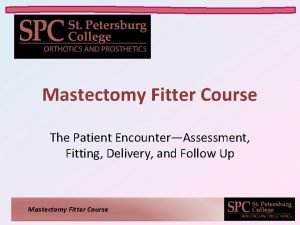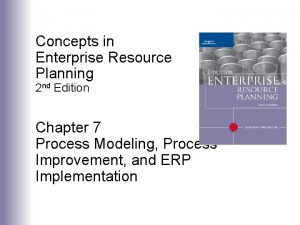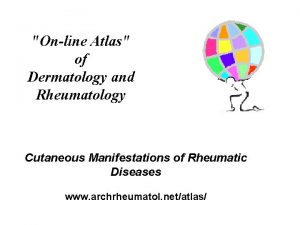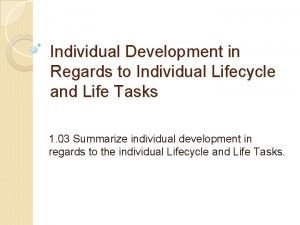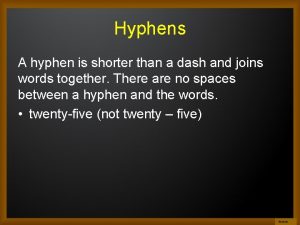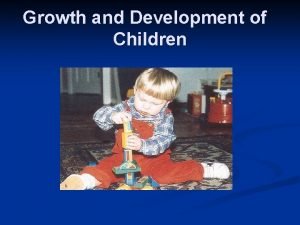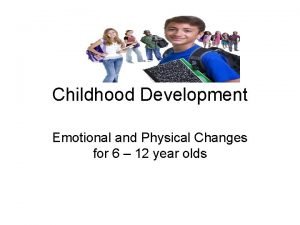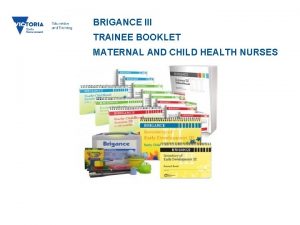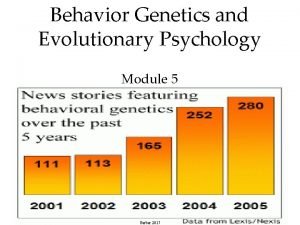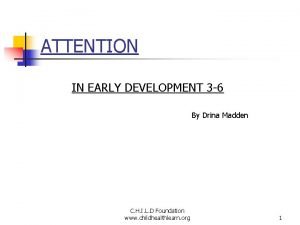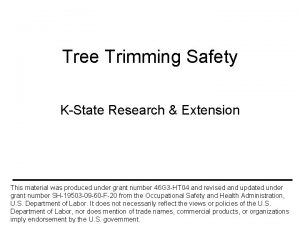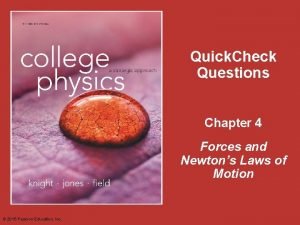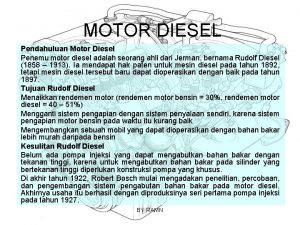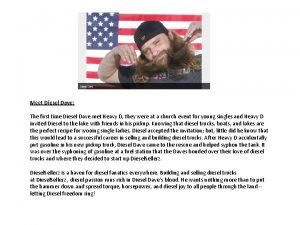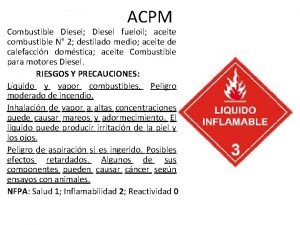Case 1 A 30 year old diesel fitter
























- Slides: 24

Case 1 A 30 year old diesel fitter was referred with the following history: • 2 years ago, 20 minutes after taking ibuprofen for a headache, he suffered from wheeze lasting for 2 hours. • More recently, after taking some naproxen for a painful hand, he noted the onset of breathlessness, wheeze with constriction of the throat, leading to loss of consciousness. He subsequently required ventilation in the ITU. He had previously taken paracetamol without any difficulty. He complained of constant “hay fever”-like symptoms and was considered to have asthma (with mainly nocturnal wheeze). Current medications were salbutamol inhaler, beclomethasone nasal spray and an oral antihistamine (cetirizine). He kept a dog. Examination showed large nasal polyps on both sides. What is the diagnosis and the significance of the nasal polyps? Would any tests or investigations be useful? What treatment(s) could be considered? What advice should the patient be given?

Case 1 What is the diagnosis and the significance of polyps? • • The diagnosis is hypersensitivity to non-steroidal anti-inflammatory drugs — often associated with non-allergic rhinitis/asthma. Polyps are much more strongly associated with non-allergic than allergic rhinitis. Would any tests or investigations be useful? • • There are no tests for NSAID hypersensitivity, other than exposing the patient to the drug(s). These reactions are not Ig. E-mediated, but due to pharmacological hypersensitivity to cyclooxygenase inhibitors. However, these reactions occurred against a background of chronic rhinitis, and so testing for sensitisation to common aero-allergens might be useful — this patient had a strongly positive skin test to grass pollens, with significantly elevated circulating pollen-specific Ig. E (negative to house dust mite, cat and dog). He had never noted any seasonal variation to his symptoms, so the significance of these findings is unclear. What treatment(s) could be considered? • Nasal polyps are often very steroid-sensitive. This patient was given Betnesol drops, reverting to an aqueous steroid spray after 3 weeks. He gained only transient benefit and was referred for polypectomy. Post-surgery, he should maintain low-dose topical steroid treatment to avoid recurrence. What advice should be given? • Avoid NSAIDs

Case 2 A 42 year old woman was referred with a 4 year history of hay fever, with symptoms of rhinitis and asthma starting in March or April of each year. She had also begun to notice a sensation of tingling around the lips and mouth, throat congestion and wheeze when eating peaches, pears, apples, hazel nuts, carrots or celery. What is the diagnosis? Would any tests or investigations be useful? What treatment(s) could be considered? What advice should the patient be given?

Case 2 What is the diagnosis? • This is an example of allergic rhinitis with “oral allergy syndrome”, due to allergy to birch pollen causing symptoms on exposure to cross-reacting allergens in a variety of fruits, particularly peach, pear, apple and plum. Other plant-derived foods are sometimes involved, as in this case. Would any tests or investigations be useful? • Skin prick testing showed a very strong response to birch pollen. Strong responses were also obtained to hazel nut, almond, carrot and celery. Extracts of the relevant fruits gave negative results. Ig. E results as follows: – – – total 52. 4 birch pollen 22. 3 apple 1. 01 carrot 1. 3 celery 0. 8 (peach, pear and plum were negative) What treatment(s) could be considered? • Because of the severity of symptoms and the possibility of accidental exposure, inhaled and injectable adrenaline were prescribed, as well as a supply of oral antihistamine. What advice should be given? • Avoidance of allergens.

Case 3 A 32 year old prison officer was referred with the following history: • • • While drinking from a can, he was stung on the lip by an insect. Although he said this was a wasp, he also said he had to remove the sting. He rapidly developed symptoms of facial angioedema, itching, tightness of the throat with difficulty breathing, progressing to loss of consciousness and double incontinence within about 15 minutes. He regained consciousness in an ambulance and, on arrival in A/E, he was treated with adrenaline, hydrocortisone, chlorpheniramine and salbutamol. One hour later, he required further adrenaline for hypotension. He was kept in hospital for a further 5 days because of atrial fibrillation. Past medical history included anxiety attacks, for which he was taking propranolol. Investigation revealed: • • Weals of 1. 5 and 3 mm to wasp venom; 1 mm to bee venom Specific Ig. E of 3. 37 to wasp and 54. 3 to bee. What is the diagnosis? Why was his reaction so severe and prolonged? How should this patient be managed?

Case 3 What is the diagnosis? – Probably bee allergy Why was his reaction so severe and prolonged? – reaction was severe because of his regular treatment with propanolol How should this patient be managed? – avoidance, emergency treatment plan, antihistamine and epipen – consider immunotherapy

Case 4 A 42 year old childminder was referred with the following history: • • While having dinner in a hotel, she noticed tingling of her lips while eating a starter of salmon, tomatoes, garlic and avocado (she had never eaten the latter before). She took an antihistamine and finished the rest of the meal which included chicken, mixed nuts and wine. On returning to her room, she experienced generalised itch and developed angioedema, followed by loss of consciousness. She regained consciousness after being given adrenaline, but took several days to recover completely. She was an atopic subject, known to suffer from hayfever and eczema. There was a past history of anaphylaxis of unknown cause, and she had previously experienced lip swelling after blowing up balloons. She itched when she wore rubber gloves. What is the diagnosis, and the link between the current episode and her previous history? Are any further tests or investigations needed? What treatment(s) could be considered? What advice should the patient be given?

Case 4 What is the diagnosis? • This history suggests food allergy. Foods not eaten before always likely candidates and, in this case, the past medical history of probable allergy to natural rubber latex provides a diagnostic clue, since latex cross-reacts with a number of dietary antigens, including avocado (notably, kiwi fruit and banana). Are any further tests or investigations needed? • • The patient had positive skin prick tests to latex and avocado. Specific Ig. E to latex was raised at 10. 2 What treatment(s) could be considered? • There is an argument for adrenaline and antihistamines to be available to this patient. What advice should be given? • Avoid contact with rubber latex and avocado. Ensure the message is communicated to relevant health care workers — consider a Medic. Alert bracelet.

Case 5 A 14 year old schoolboy was referred with the following history: • • • At the age of 7, he was seen to develop swelling of the face, blotchiness of the skin and severe breathing difficulty within 1 hour of eating a small piece of brazilnut. He had avoided these since that time. He was aware that he could eat peanuts, hazelnuts, almonds, cashews and pistachios without any difficulty, and is keen to know if it is now OK to eat brazilnuts again. He had previously experienced a skin rash while taking penicillin, and sneezing and wheeze on exposure to (some) dogs. He thought he had mild hay fever and he suffered from mild hand eczema. Blood tests showed: • • total Ig. E 68. 8 Ig. E to peanut <0. 35 Ig. E to hazelnut <0. 35 Ig. E to brazilnut <0. 35 What is the diagnosis? Are any further tests or investigations needed? What treatment(s) could be considered? What advice should the patient be given?

Case 5 What is the diagnosis? • The history is highly suggestive of allergy to brazilnut. Are any further tests or investigations needed? • In view of the history, skin prick tests were performed — these showed a very strong positive response to brazilnut and a weak positive to hazelnut (negative to other nuts). There were additional positive responses to cat, dog, house dust mite and grass pollen allergens. What treatment(s) could be considered? • Assuming the patient wishes it, he should have a supply of adrenaline for self-administration in the event of further anaphylactic attacks. He should also keep an oral antihistamine. A Medic. Alert bracelet was recommended. What advice should be given? • Avoidance of all nuts is the safest advice, but many patients will reach their own conclusions about what they can and can’t eat.

Case 6 A 36 year old education inspector was referred with the following history: • • • Earlier in the year, she bought a chicken, cheese and mushroom dish from the supermarket. The instant the food touched her lips, she experienced burning of her hands and feet, generalised itching, swelling of the face, tongue and throat and vomiting. At A/E, she was noted to be hypotensive and was given steroid antihistamine. 20 minutes before the onset of symptoms, she had given some amoxicillin suspension to her young daughter, and had licked the spoon afterwards. There was a past history of eczema and pre-eclampsia. What is the diagnosis? Are any further tests or investigations needed? What treatment(s) could be considered? What advice should the patient be given?

Case 6 What is the diagnosis? • Food allergy is unlikely as the onset of systemic symptoms occurred too soon after contact (in less time that it would take for antigen to circulate!) However, the earlier exposure to a penicillin is suspicious. Are any further tests or investigations needed? • • The patient had a strongly positive skin prick tests to amoxicillin (negative to penicillin and its major and minor determinants). Specific Ig. E to the amoxicilloyl moiety was raised at 1. 63 (total Ig. E 48. 5) What treatment(s) could be considered? • Although the patient had already been prescribed a supply of adrenaline, this was not renewed as accidental exposure was considered to be unlikely. However, a Medic. Alert bracelet should be considered. What advice can be given for the future? • All penicillins should be avoided in future, as should cephalosporins — previous estimates of the frequency of cross-reaction of about 15% were probably underestimates as they included non-Ig. Emediated reactions. Where the mechanism of penicillin allergy is genuinely anaphylactic, crossreaction rates are likely to be much higher.

Case 7 A 39 year old man was referred with a 1 year history of asthmatic symptoms, sometimes with quite marked exacerbations. As a child, he was said to have been allergic to cats. However, although he had recently bought a cat, his symptoms preceded this by several months. For the last 3– 4 years, he had also experienced hay fever symptoms. In the clinic, his peak expiratory flow rate was 400 l/min. , which was low for his age and height. What is the diagnosis? Are any further tests or investigations needed? What treatment(s) could be considered? What advice should the patient be given?

Case 7 What is the diagnosis? • Asthma. Are any further tests or investigations needed? • • The patient had positive skin prick tests to grass pollen, alternaria, cat and dog. Ig. E tests showed: – – – total Ig. E 109 cat 26. 3 dog 3. 33 alternaria 3. 99 grass pollen 4. 49 What treatment(s) could be considered? • The patient was treated as for asthma, with inhaled steroid and salbutamol, to which salmeterol was later added. What advice should be given? • In view of the significance of his symptoms, and the fact that he was clearly sensitised to cat allergen, this patient was advised to find another home for the family cat.

Case 8 A 17 year old girl was referred with a history of longstanding severe eczema. She was aware of itching within 2 hours or so of eating a number of foods (pork, citrus fruits, jams and foods containing benzoates or other preservatives). In the past, it was thought that she might be allergic to eggs, wheat and nuts, but she was unsure about this. She had undergone trials of dietary exclusion under the care of the dermatologists, but without success. What is the role of food allergy in atopic eczema? What further tests or investigations needed, if any? What advice should the patient be given?

Case 8 What is the role of food allergy in atopic eczema? • There is no consensus that eczema is aetiologically related to dietary allergy. Are any further tests or investigations needed? • • • Allergy testing was considered only because of the historical suggestion of immediate-type symptoms. The patient’s eczema was too severe to perform skin prick tests. Ig. E tests showed: total Ig. E 1, 872 house dust mite >100 grass pollens 35 wheat 4. 78 milk 6. 62 egg 0. 38 • cod <0. 35 peanut 7. 22 orange 1. 31 lemon 1. 8 pork 2. 12 As is frequently the case in eczema, specific Ig. E testing gave results which were virtually impossible to interpret. For example, she knew that she was able to drink milk without any difficulty. Allergy testing is a very poor guide to the management of eczema as these patients often have positive skin tests and circulating Ig. E to substances which they can tolerate. Similarly, whether the other symptoms she reported are actually due to type I hypersensitivity to food antigens is a moot point — oral challenge testing would be the only way to establish this. This is rarely necessary, as these patients have usually decided for themselves what they can or cannot tolerate. However, it may be indicated in cases where the diet is being seriously restricted or where foods which have been avoided are being reintroduced. What advice should be given? • Eat as normal a diet as possible, avoiding those foods which reliably cause symptoms.

Case 9 A 47 year old woman, a production worker in a cake factory, was referred with the following history: • 7 months ago, she woke up in the middle of the night with gross facial angioedema. Since then, there had been 3 further episodes with involvement of the tongue and/or lips when she had difficulty talking/breathing. The onset of symptoms was entirely unpredictable. • She had suffered from spontaneous coughing fits for a long time. • She was a hypertensive, on enalapril for the last 8 years, with the recent addition of a diuretic. What is the diagnosis? Would any tests or investigations be useful? What treatment(s) could be considered? What advice should the patient be given?

Case 9 What is the diagnosis? • This is non-allergic angioedema, which can be exacerbated or even caused, by ACE inhibitors — a phenomenon which is, unfortunately, not as well-known as it is well-documented in the literature! This symptom can appear for the first time even after prolonged therapy. Dry cough is also a common side-effect of this group of drugs. Would any tests or investigations be useful? • One can debate whether any further investigations are necessary, but it would seem reasonable to withold further investigations until the symptoms have been seen not to have resolved after stopping ACE inhibitor treatment. What treatment(s) could be considered? • The patient should not be given any ACE inhibitor again. Substitution of an angiotensin II receptor antagonist seems reasonable, but it should be borne in mind that even these are occasionally associated with angioedema (although it is difficult to propose by what mechanism). What advice should be given? • Avoidance of ACE inhibitors.

Case 10 A 38 year old male chef was referred with the following history: • • • For several months, he had experienced daily episodes of urticaria, which had become progressively worse and were increasingly accompanied by marked swelling around the lips and eyes. On a number of occasions, he had experienced tightness of the throat with difficulty breathing, and had been admitted overnight from casualty for observation. On the most recent occasion, he was artificially ventilated. Symptomatic episodes were entirely unpredictable and unrelated to any discernable trigger. He was a diet-controlled diabetic and had a previous history of Prinzmetal’s angina. What is the diagnosis? Are any further tests or investigations needed? What treatment(s) could be considered?

Case 10 What is the diagnosis? • This is idiopathic urticaria/angioedema/anaphylaxis. This case was at the more severe end of the spectrum of this condition. Are any further tests or investigations needed? • Investigations are characteristically negative, although evidence of infection (including dental infection) should be sought. If angioedema is unaccompanied by urticaria, hereditary or acquired C 1 inhibitor deficiency should be excluded (complement component C 4 will almost always be very low). What treatment(s) could be considered? • A typical therapeutic progression would be: – – • H 1 anagonist double dose add H 2 antagonist (or dothiepin) tranexamic acid A supply of adrenaline was given and used successfully on a number of occasions.

Case 11 A 31 year old woman was referred with the a 7 year history of episodic abdominal pain which had been said to be of hysterical origin. Episodes of cramping pain were entirely unpredictable and lasted for up to several days before resolving spontaneously. Her father and a paternal aunt had died suddenly in middle age and from no obvious cause. Her two young daughters had been noted to have episodes of swelling of the face or limbs and were being treated with antihistamines for this. What is the diagnosis? Are any further tests or investigations needed? What treatment(s) could be considered? What advice should the patient be given?

Case 11 What is the diagnosis? • This history is very suggestive of hereditary angioedema. This is due to a deficiency of C 1 inhibitor, and is inherited in an autosomal dominant fashion. Although externally apparent angioedema is common, patients can have predominantly internal symptoms, e. g. with mucosal oedema of the gut, as in this case. Sudden death from respiratory obstruction is well documented and is the most disastrous consequence of non-diagnosis. Are any further tests or investigations needed? • One of the few occasions in which tests done by the diagnostic immunology lab. are absolutely diagnostic(!): – C 4 <0. 1 (0. 2– 0. 5) – C 1 inh. 0. 03 (0. 08– 0. 26) What treatment(s) could be considered? • Treatment is virtually mandatory, and all patients with this condition should be under long-term follow up by a clinical allergist or immunologist. C 1 inh. levels can be increased by treating with low-dose androgens (danazol, stanozolol). These are contraindicated in pregnancy, when tranexamic acid is used. What advice can be given for the future? • Patients should avoid unnecessary physical trauma and seek early medical attention for severe attacks. A Medic. Alert bracelet should be considered.

Case 12 A 51 year old woman was referred with the following history: • • • For many years, she had experienced a variety of symptom on exposure to chlorinated water, hydrocarbon gases (methane, propane and butane), various odours/scents, and some foods. Immediately following exposure, she would experience shakiness and dizziness followed, the next day, by headache, vomiting, vertigo and fluid retention. She could not even bathe in normal tap water and distilled all her own water at home. She had previously seen a private allergy specialist who had offered desensitisation therapy to chlorine and other substances, with transient benefit. She had undergone a diagnostic test for food allergy/intolerance at a health food shop and was advised to avoid wheat, milk, eggs and potatoes. Examination suggested a pleasant individual who was rather underweight and frail-looking and whose personal hygiene was in doubt. What is the diagnosis? Are any further tests or investigations needed? What treatment(s) could be considered? What advice should the patient be given?

Case 12 What is the diagnosis? • The patient is in thrall to an irrational belief system centred on allergy. Are any further tests or investigations needed? • No. Negative skin prick tests to the foods she had been told to avoid failed to convince this patient that she was not suffering from food allergy. What treatment(s) could be considered? • There is no physical treatment from which this patient is likely to benefit. She was unwilling to countenance the possibility that her perception of ill health was mainly (if not entirely) phsychosocial in aetiology, and so would have been unwilling to seek appropriate treatment (even if it were available!). What advice should be given? • She was advised to eat a normal diet but subsequently wrote to the consultant to say that this had made her “feel awful”. She was discharged from the clinic and told that she could not be helped in the context of an orthodox allergy practice.
 Fitter patient
Fitter patient Fitter snacker
Fitter snacker Concepts in enterprise resource planning
Concepts in enterprise resource planning Fitter snacker
Fitter snacker Fitter snacker
Fitter snacker Best case worst case average case
Best case worst case average case Year 2 leavers poem
Year 2 leavers poem Normal bpm range for female
Normal bpm range for female Great gatsby lesson
Great gatsby lesson 42 year old woman
42 year old woman Iep examples
Iep examples Average height of a 3 year old in centimeters
Average height of a 3 year old in centimeters 9-year-old physical development
9-year-old physical development Long lasting hyphen
Long lasting hyphen Average weight for 8-year-old boy
Average weight for 8-year-old boy Weight for a 11 year old
Weight for a 11 year old 9-year-old physical development
9-year-old physical development Brigance iii scoring
Brigance iii scoring Brigance scoring chart
Brigance scoring chart One year old marcus turns away in disgust
One year old marcus turns away in disgust Adhd in 3 year old
Adhd in 3 year old Newborn infants typically prefer
Newborn infants typically prefer Jerome believes that his 4-year-old grandson
Jerome believes that his 4-year-old grandson Osha tree trimming safety book
Osha tree trimming safety book A steel beam hangs from a cable
A steel beam hangs from a cable
